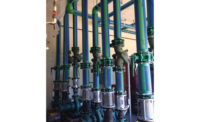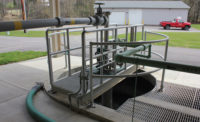Neenah Paper Inc. is a producer of premium image and performance-based products, including filtration, specialized substrates used for tapes, labels and other products. It also produces high-end printing papers.
Following NPI’s acquisition of Wausau Paper’s Astrobrights brand, the Whiting Mill in Stevens Point, Wis., needed to expand its manu-facturing capability to meet the unique demand of producing brightly colored papers.
To produce this paper, staff at the central Wisconsin-based paper mill sought solutions to store and distribute more than 24 liquid dyes from one of four sizes of supply tanks to multiple distribution points throughout the mill. Finding the right distribution piping material was top priority.
Numerous types of piping materials were considered. “Stainless steel was the default consideration, but it is expensive,” NPI Mechanical Engineer Kevin Calhoun says. “Some of the dyes eat through stainless pipe in a matter of weeks, which would result in a mixed-material installation, thus limiting flexibility in moving dyes between different tanks.” Additionally, the corrosion of steel pipe translated into a waste of resources and precious operating funds.
Seeking a single solution
The challenge was finding a single solution that was less expensive than polytetrafluorethylene tubing or welded stainless steel, more resilient and thermo-dimensionally stable than glued chlorinated polyvinyl chloride or polyethylene tubing and with greater chemical resistance than stainless steel or CPVC. Onsite polypropylene piping demonstrations greatly alleviated technical concerns about the material in general, as well as the quality, speed and complexity of fusion-welded joints.
The plant selected Aquatherm’s Blue Pipe (formerly known as Climatherm) polypropylene-random piping system. Blue Pipe offers all the ad-vantages of Aquatherm Green Pipe (such as the strengthening characteristics of the faser layer), but is engineered with thinner walls for higher flow rates and is high-heat stabilized. This allows it to be manufactured as standard dimension ratio 11 instead of SDR 7.4 and reduces pipe weight, improves its flow rate and keeps it competitive with comparable nonpotable systems.
Polypropylene’s chemical resistance made it a suitable choice for across-the-board use in this particular dye system. “This application was primarily focused on the chemical resistance of polypropylene, which, as we learned in our research, is frequently used in lab waste applications as a cost-competitive cousin to PVDF (polyvinylidene fluoride),” Calhoun explains.
In the end, two factors made the biggest impact. First, the faser composite technology addressed thermo-dimensional stability and provided pressure use capability unconventional to plastic piping systems. Second, Calhoun was impressed with the system’s warranty, which included not only replacement cost of failed piping, but associated equipment damage due to failed piping, as well as additional per-event personal injury coverage.
Time crunch
Neenah Paper was up against the clock. Despite not starting until March 2012, there was a fixed startup deadline of August 2012. “NPI takes pride in unmatched customer service and product availability,” Calhoun states. “Missing the August startup date would have risked service inter-ruptions to customers, so the installation needed to be done quickly, correctly and without issues.”
Little time was available to develop a project budget and very little design work was invested into technical designs, so in order to expedite funding availability, the budget was developed based on using 316 stainless-steel welded construction for all piping. The challenge then became delivering a cost-effective solution.
“Initial estimates put raw material costs roughly equivalent to that of CPVC. In the end, costs were slightly higher than CPVC, but still less than half the cost of stainless,” Calhoun says.
The task seemed tall. About 2,500 ft. of 1 1/2-in. pipe and more than 1,000 fusion joints were needed to comprise the system, which would transfer dye from totes to one of dozens of bulk tanks. About 5,450 ft. of 1 1/4-in. piping and another 3,400 ft. of 1-in. piping, held together by more than 4,500 fusion joints, needed to transfer dye from the bulk tanks to one of nearly 400 service taps and valves.
A little more than 1,000 ft. of 3/4-in. pipe would carry diluted dyes. Another 6,750 ft. of 1/2-in. pipe, connected by at least 1,750 fusion joints, needed to carry dye from the metering pump area to where it is injected in the process. In all, more than 19,000 ft. of pipe, connected by roughly 4,250 fittings and valves (by more than 7,300 fusion welds), were installed with zero leaks, passing the manufacturer’s rigorous pressure test pro-cess the first time.
“When the pressure test was done at the completion of the job, Neenah Paper did not have one recordable leak at any of the joints,” says Brad Murphy, account manager of Columbia Pipe & Supply’s branch in Schofield, Wis. Chicago-based Columbia served as the distributor on the job.
Complicating the task were workers enduring extreme conditions in some of Wisconsin’s hottest temperatures. “The job took place during the hot summer months and in lower levels of the paper mill with minimal air circulation,” says Tony Heil, project manager of Appleton, Wis.-based mechanical contractor August Winter & Sons. Heil notes cost comparisons showed the installation at Whiting Mill saved NPI about 58% on the install labor and 51% on material.
While polypropylene valves with threaded ends are traditionally specified, Aquatherm offered only fusion-welded joints and molded-in metal joints due to the potential for plastic threads becoming a failure point on thermal-cycling applications. Since nearly all the valves in the system needed to be threaded to adapt to some other instrument or piping system, such as a hose barb and length of hose, adding a third-party all-plastic threaded adapter wasn’t an option due to cost and space.
“Working together, Columbia and Aquatherm found a solution to modify and source polypropylene-threaded valve ends,” says Calhoun, who also lauded the efforts of Skip Newton of Arlington Heights, Ill.-based manufacturers rep PVF Solutions.
New territory
There was some apprehension regarding the job due to the fact the mechanical contractor was new to the product. “Since August Winter & Sons was installing this for the first time, the pipefitters needed to be trained and certified on the product prior to commencing work on the job,” Murphy explains.
Following the final selection of the Aquatherm system, Calhoun worked with Columbia Pipe and Aquatherm to coordinate installer training of NPI and August Winter personnel. Following the training course, all the installers were confident in their abilities and within a couple days of working with the product were heat-fusing pipe.
“All the guys in the field say it is easier and faster to install,” Heil says. August Winter’s crew even utilized custom-made jigs to ensure high productivity and joint uniformity. “We built a jig to align the pipe when putting couplings and lengths together so the pipe would lie straight in the channel,” Heil adds.
Nearing the end of the project, an off-cut was discovered in the facility’s waste barrel with a dimensional anomaly on the pipe ID. Columbia Pipe and Aquatherm analyzed the segment and offered several possible solutions. The system could be operated without concern of failure as long as the service pressure didn’t increase beyond a specified point in the future.
“People in the paper industry know change is always happening so replacement was considered,” Calhoun says. Aquatherm was aware that the defect occurred and thought all suspect pipe had been recycled at its manufacturing facility in Germany. That continuous quality data allowed them to narrow down the suspect pipe to one pipe size within a 30-minute manufacturing window.
August Winter and Columbia Pipe staff inspected every foot of the suspect pipe size in the system for the specified date and time code and Aquatherm replaced the pieces found with the defect.
Since initial startup in August 2012, the mill has not had any issues with the piping system. It is now considered a viable alternative for almost any type of piping additions to the mill from compressed air and potable water to chemical delivery — pending satisfactory chemical resistance analysis.
“The bundles of colored pipe also make for a great discussion point during customer tours,” Calhoun says.
James Paschal, P.E., LEED AP, is Aquatherm’s chief technology officer. He has more than 24 years of experience in the plastic piping industry, includ-ing 14 years with NSF.






